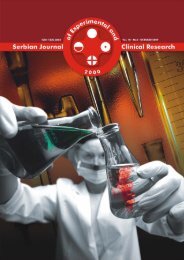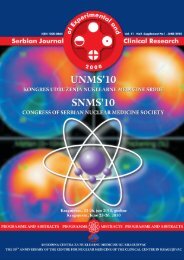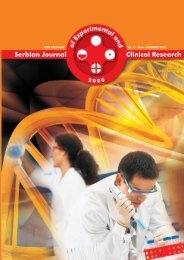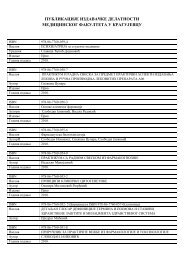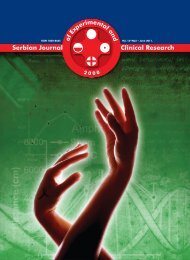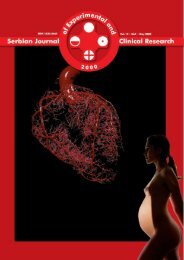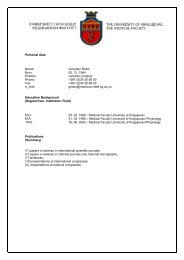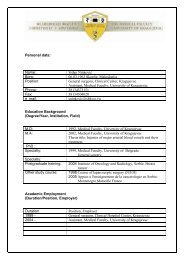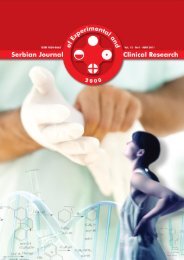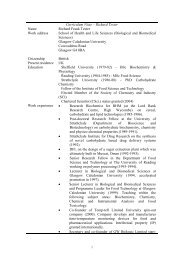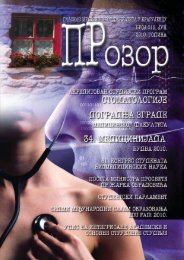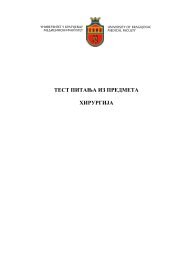Untitled - Medicinski fakultet Kragujevac - Univerzitet u Kragujevcu
Untitled - Medicinski fakultet Kragujevac - Univerzitet u Kragujevcu
Untitled - Medicinski fakultet Kragujevac - Univerzitet u Kragujevcu
Create successful ePaper yourself
Turn your PDF publications into a flip-book with our unique Google optimized e-Paper software.
46<br />
that patients who had pressure ulcers at admission are 4<br />
times more likely to regain pressure ulcers during rehabilitation<br />
after controlling for all of the factors in the model.<br />
Another statistically significant predictor of pressure ulcers<br />
during rehabilitation was FIM score at admission (B<br />
= -0036, p = 0.015).<br />
DISCUSION<br />
In our study, PU was present in 15.5% of the sample<br />
during a 10-year study period. Garber and Rintala found<br />
PU in 36% of their mail-based survey and 39% of 553 veterans<br />
in the Houston VA SCI registry over a 3-year period<br />
(15). Age of SCI onset, SCI duration, presence of depression,<br />
and faecal/urinary incontinence showed no significant<br />
association with the presence or development of PUs.<br />
Similar to the findings of Salzberg et al., Mawson et al.<br />
and Rodriguez and Garber found diabetes mellitus, smoking,<br />
and depression to influence PU development (15,16).<br />
Many risk factors are associated with the development of<br />
pressure ulcers in SCI patients. All of these factors were<br />
associated with PUs; it is not known whether they increase<br />
the risk of PU development or are the result of PUs.<br />
In our study, the most commonly reported location of<br />
pressure ulcers was at the sacrum (77.1%), followed by the<br />
trochanter (11.4%), ischium (8.5%) and heel (2.8%). In other<br />
studies, the sacrum was the most commonly reported<br />
location (39–52%), followed by the ischium (8–59%) and<br />
heel (13–31%) (17).<br />
Using a simple logistic regression, we found that statistically<br />
significant predictors of PUs were mode of trauma, completeness<br />
of injury, PUs in acute phase of rehabilitation and<br />
FIM score at admission. Age, gender, duration of rehabilitation<br />
and neurological level of injury were statistically insignificant<br />
for the development of PUs during functional rehabilitation.<br />
In our study, the neurological level of injury was statistically<br />
insignificant as a PU predictor. Therefore, PUs occur more<br />
frequently in paraplegic patients than tetraplegic patients.<br />
Previous studies have reported similar findings (7,18,19).<br />
Using the multiple logistic regression model, we found<br />
that statistically significant predictors of PUs were pressure<br />
ulcers in the acute phase of rehabilitation and FIM<br />
score at admission. A pressure ulcer in the acute phase of<br />
rehabilitation was a strong predictor of PUs during functional<br />
rehabilitation, with OR = 4.1. This result shows that<br />
patients who had a pressure ulcer at admission had a fourtime<br />
greater probability of regaining a pressure ulcer during<br />
functional rehabilitation. Similar findings have been<br />
reported in a previous study. Verschueren et al. showed<br />
that a pressure ulcer in the acute phase of rehabilitation<br />
was a strong predictor of PUs, with OR=5.1 (19). In our<br />
study, FIM score at admission was a strong predictor for<br />
the development of pressure ulcers. This finding is in accordance<br />
with previous studies (19). This association is<br />
because increased immobilisation (due to absent motor<br />
function) promotes the development of PUs.<br />
CONCLUSION<br />
Significant risk factors for developing pressure ulcers<br />
during acute and functional rehabilitation are pressure ulcers<br />
during the acute phase of rehabilitation and FIM score<br />
at admission. Because PUs have a significant impact on rehabilitation<br />
and functional outcomes in patients with SCI,<br />
it is necessary to construct a predictive model for the development<br />
of pressure ulcers. Developing a model for the<br />
prediction of PUs allows us to recognise risk categories of<br />
patients and react in terms of prevention or treatment of<br />
PUs. This study emphasises the need to continue educating<br />
patients with SCI about the importance of effective regular<br />
healthy skin care in preventing PU development.<br />
REFERENCES<br />
1. Correa GI, Fuentes M, Gonzalez X, Cumsille F, Pin JL,<br />
J Finkelstein J. Predictive factors for pressure ulcers in<br />
the ambulatory stage of spinal cord injury patients. Spinal<br />
Cord 2006; 44: 734–739.<br />
2. Consortium for Spinal Cord Medicine Clinical Practice<br />
Guidelines. Pressure ulcer prevention and treatment<br />
following spinal cord injury: a clinical practice guideline<br />
for health-care professionals. J Spinal cord med<br />
2001; 24 (Suppl 1): S40–S101.<br />
3. Saladin LK, Krause JS. Pressure ulcer prevalence and<br />
barriers to treatment after spinal cord injury: comparisons<br />
of four groups based on race-ethnicity. Neuro Rehabilitation<br />
2009; 24: 57–66.<br />
4. Rabadi MH, Vincent AS. Do vascular risk factors contribute<br />
to the prevalence of pressure ulcer in veterans with<br />
spinal cord injury? J.Spinal Cord Med 2011; 34: 46-51.<br />
5. Yarkony GM, Heinemann AW, Stover SL, DeLisa JA,<br />
Whiteneck GG (eds.). Spinal cord injury: clinical outcomes<br />
from the model systems. Aspen Publishing;<br />
1995. p. 100–19.<br />
6. Byrne DW, Salzberg CA. Major risk factors for pressure<br />
ulcers in the spinal cord disabled: a literature review.<br />
Spinal Cord 1996; 34: 255–263.<br />
7. Chen Y, Devivo MJ, Jackson AB: Pressure ulcer prevalence<br />
in people with spinal cord injury: age-periodduration<br />
effects. Arch Phys Med Rehabil 2005; 86:<br />
1208–1213,.<br />
8. Smith BM, Guihan M, LaVela SL, Garber SL. Factors<br />
predicting pressure ulcers in veterans with spinal cord<br />
injuries. Am J Phys Med Rehabil 2008; 87: 750–7.<br />
9. Krause JS. Skin sores after spinal cord injury: relationship<br />
to life adjustment. Spinal Cord 1998; 36: 51–6.<br />
10. National Pressure Ulcer Advisory Panel. Pressure ulcer<br />
stages revised by NPUAP. 2007 [accessed 2010 Jun 6].<br />
Available from: http://www.npuap.org/pr2.htm.<br />
11. Uniform Data System for Medical Rehabilitation.<br />
Guide for the Uniform Data Set for Medical Rehabilitation<br />
(including the FIMt Instrument), version 5.1. State<br />
University of New York: Buffalo 1997.



